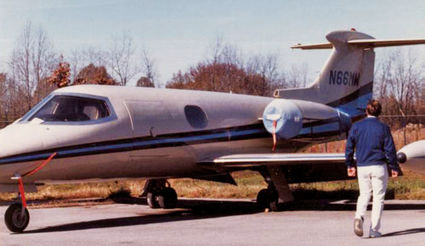It's important to have dreams
Short Flights
October 24, 2020
Isn't it amazing when you can experience a lifelong dream? When I was in my early 20s, I loved looking in "Trade-A-Plane" for airplanes I couldn't afford in a million years; aircraft like P-51 Mustangs, F4U Corsairs and LearJets. There is a certain romance in dreaming and I have learned that it is a significant part of a happy life.
When Al planned a trip for us to Clarksville, Tennessee in 1987, to look at a Lear 23 that was listed in "Trade-A-Plane" I didn't have a clue that he would actually buy it. I still have the vision in my memory of him walking out to this magnificent aircraft parked on the ramp at Clarksville Airport. I knew then that he was smitten and we were purchasing the plane I had only dreamt of. What a thrilling way to fly!
We flew it home to Mojave the next day. We had a pilot/instructor who was rated in the Lear, who checked Al out on the way. We made one stop for fuel.
Approximately 105 Lear 23s were built from 1963 to 1966. The fuselage measured 43 feet and the wingspan was 35.5 feet. The fully pressurized Lear was powered with two General Electric CJ610-4 turbojet engines and had a windshield and large cabin windows fabricated from stretched and laminated acrylic plastic. It could fly at a top speed of 564 mph, with a range of 1,875 miles. With an engine thrust-to-weight ratio of 1:2.2 pounds, a Model 23 could out climb an F-100 Super Sabre to 10,000 feet, and can be just as impressive on the way down.
The history of the Learjet is unique and William P. Lear, Sr. was without a doubt a genius, not only in the aircraft industry, but also with electronic devices. He was born in 1902 in Hannibal, Missouri and dropped out of school in the Eighth Grade and had his own electronics business at the age of 13. When 16, he joined the Navy in 1918, the last year of World War I.
In 1922, at the age of 20, Lear founded Quincy Radio Laboratory, and invented the first workable automobile radio. In 1924, Lear signed over the rights to this invention to Motorola, Inc.
His electronic companies played a significant role during World War II. He invented the first reliable aeronautical radio compass and an automatic pilot system called the "Learmatic Navigator," which kept planes on course by locking onto whatever radio broadcasts the apparatus picked up.
After World War II, Lear perfected a miniature autopilot for fighter jets, and developed the first fully automatic landing system, which won him the Federal Aviation Administration's Collier Trophy in 1950. Through the years, Lear had earned over 120 patents for milestone electronic systems inventions, including audio eight-track tape players.
His Lear Model 23 was inspired by the single-seat Swiss prototype strike fighter aircraft, Pilatus P-16. He had planned to retire in Switzerland, but abandoned the idea when he established the Swiss American Aircraft Company in 1959 and began designing the now famous Model 23.
He moved his assembly and Lear production plant to Wichita, Kansas and first flight occurred on October 7, 1963 and he received formal FAA certification on July 31, 1964.
The Learjet 23 became the first small jet aircraft to enter mass production, and was the first to be developed and financed by a single individual. Since 1990, the Canadian corporation Bombardier Learjet has produced the larger models of Learjets.
In the 1970s, Lear's aircraft designs included the Canadair Challenger (certified at Mojave Airport) and the Lear Fan, an airplane built entirely from composites.
Unfortunately, Bill Lear died from leukemia during development of the Lear Fan in May 1978.
See you on our next flight!





